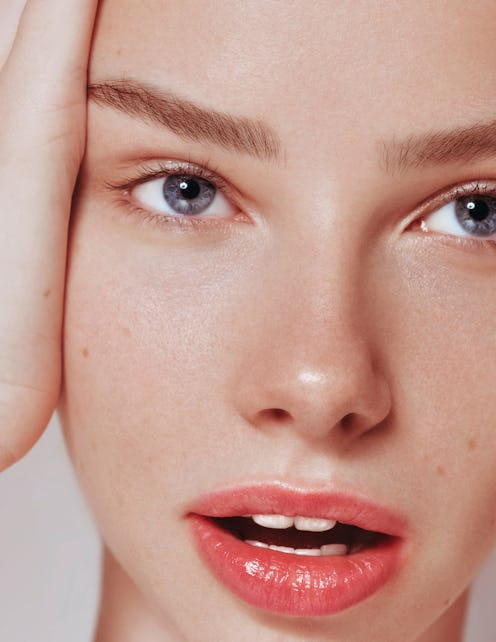(Skin)
Can Neuropeptide Skin Care Products Really Mimic The Effects Of Botox?
Dermatologists spill.

It’s not unusual — like, at all — for a skin care product to be formulated with peptides. Though the class of ingredients isn’t a recent discovery, nor new in terms of skin care formulating, peptide-infused products are arguably one of the biggest beauty trends of 2024. They’re often featured in creams, serums, masks, and more for helping to promote firmer-looking skin and minimize other signs of aging like sagging and uneven texture. The interest in peptides doesn’t seem to be slowing down either, with neuropeptides (a specific class of peptides) gaining more popularity in skin care products.
As the prefix “neuro” may have clued you in, neuropeptides are a group of peptides that play a role in signaling protein production within the body. They’re generally promoted by beauty brands as an ingredient that helps relax and soften fine lines and wrinkles, but you may have even heard they offer a Botox-like effect, too.
Ahead, board-certified dermatologists explain the growing hype behind neuropeptides, what they can and can’t do, and if that “nature’s Botox” claim rings true.
What Are Neuropeptides?
“Neuropeptides are short chains of amino acids that act as chemical messengers,” explains Dr. Melanie Palm, M.D., a board-certified dermatologist and cosmetic surgeon at Art of Skin MD in San Diego, Calif. “When applied to the skin topically, neuropeptides have been shown to stimulate collagen, elastin, and hyaluronic acid production, which is why they’re often marketed as a topical alternative to neurotoxins like Botox.”
She adds that studies have shown that certain neuropeptides can limit the release of neurotransmitters that cause muscle contractions — hence the claim that neuropeptides mimic a Botox-like effect. However, the results of applying a neuropeptide-spiked serum and that of a powerful and long-lasting injectable neurotoxin can’t be compared ... more on that below.
What Are The Different Types Of Neuropeptides?
According to Palm, the most effective neuropeptides used in skin care formulations are Matrixyl, Argireline, palmitoyl oligopeptide, and palmitoyl tetrapeptide-7. “Each neuropeptide has a different function, from stimulating collagen production to protecting from sun damage,” she notes.
Dr. Jeannette Graf, M.D., a board-certified dermatologist and assistant clinical professor of dermatology at Mt. Sinai School of Medicine, says that since there are different types of neuropeptides, they require testing to ensure they are actually delivered to the skin, and therefore are effective. “Their function is dependent on which specific cell receptors they recognize in order to have the desired effect,” she says. “Some stimulate collagen and elastin production while others prevent their degradation to sustain younger-looking skin.”
Why Are Neuropeptides Used In Skin Care Products?
There are a few potential benefits of utilizing neuropeptides in topical products. “The idea behind using neuropeptides in skin care is to utilize their ability to communicate with skin cells and produce more collagen which comes from applying topically,” explains Graf. “The signals sent within the skin will be helpful in promoting processes like relaxation of facial muscles, collagen production, as well as strengthening skin barrier and improving its overall appearance.”
According to Palm, since neuropeptides mimic signaling that affects nerves, they may impact sensory nerves, and therefore potentially minimize the discomfort or side effects felt after certain procedures.
“For example, neuropeptides found in newer post-procedure creams have been shown to remarkably decrease discomfort, redness, and swelling, following in-office procedures such as microneedling or energy-based devices or laser devices,” she explains.
Can Neuropeptides Offer The Same Effect As Botox?
The short answer is no. While it certainly would be convenient for a moisturizer to offer the same muscle-freezing effect as Botox, the ingredients are not a replacement for injectable neurotoxins. They just don’t offer the same dramatic and long-lasting effects.
Dr. David Kim, M.D., a board-certified dermatologist at Idriss Dermatology in New York City, says that botulinum toxin (the active ingredient in Botox) functions by blocking the release of the neurotransmitter acetylcholine (ACh). “ACh is a signal that tells a muscle to contract,” he says. “So by stopping that signal, the toxin cuts the communication between the nerve and a muscle.” He adds that Argireline, a neuropeptide also known as acetyl hexapeptide-8, is proposed to work in a similar fashion. But again, the results aren’t comparable.
“Certain neuropeptides such as Argirilene have been used in skin care, and in addition to helping collagen production, they have been able to relax facial muscles creating decreasing lines and wrinkles caused by movement,” explains Graf. “While these neuropeptides can reduce signs of aging by relaxing facial muscles emulating the effects of ‘Botox,’ they are not nearly as effective as injectable neurotoxins.”
As Dr. Palm explains, a topically-applied neuropeptide is mostly likely to impact the outer layers of skin. “This means neuropeptides will likely be ineffective in treating wrinkles in areas of the face that experience a lot of movement, like around the mouth, eyes, and forehead,” she says.
One way to possibly capitalize on the effects of neuropeptides is to use them in conjunction with injectable neurotoxins. Dr. Graf says neuropeptides can “enhance the anti-aging effect since they also improve collagen production.”
Palm says that studies have shown that topical application of neuropeptides has decreased the amount of wrinkling around the eye when used in conjunction with a neuromodulator.
So while neuropeptide-infused skin care products definitely aren’t Botox in a bottle, depending on the formulation, they could still be a beneficial addition to your routine. Your best bet? Check in with a board-certified dermatologist to ensure the ingredient (or even an injection treatment) is right for you.